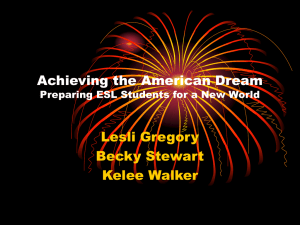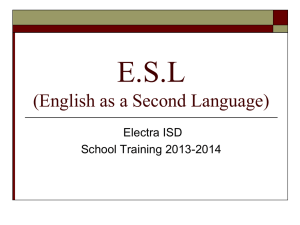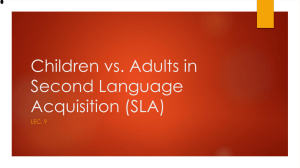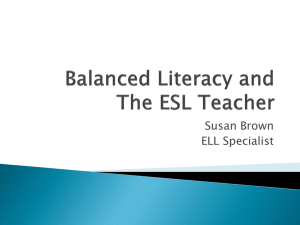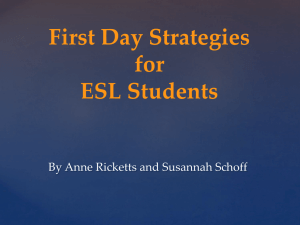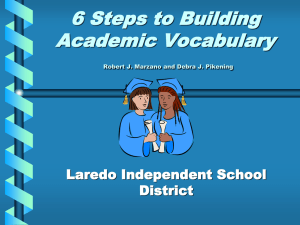WIOA TRANSITIONS GRANT ACTIVITY – Kim Ward, notes by
advertisement
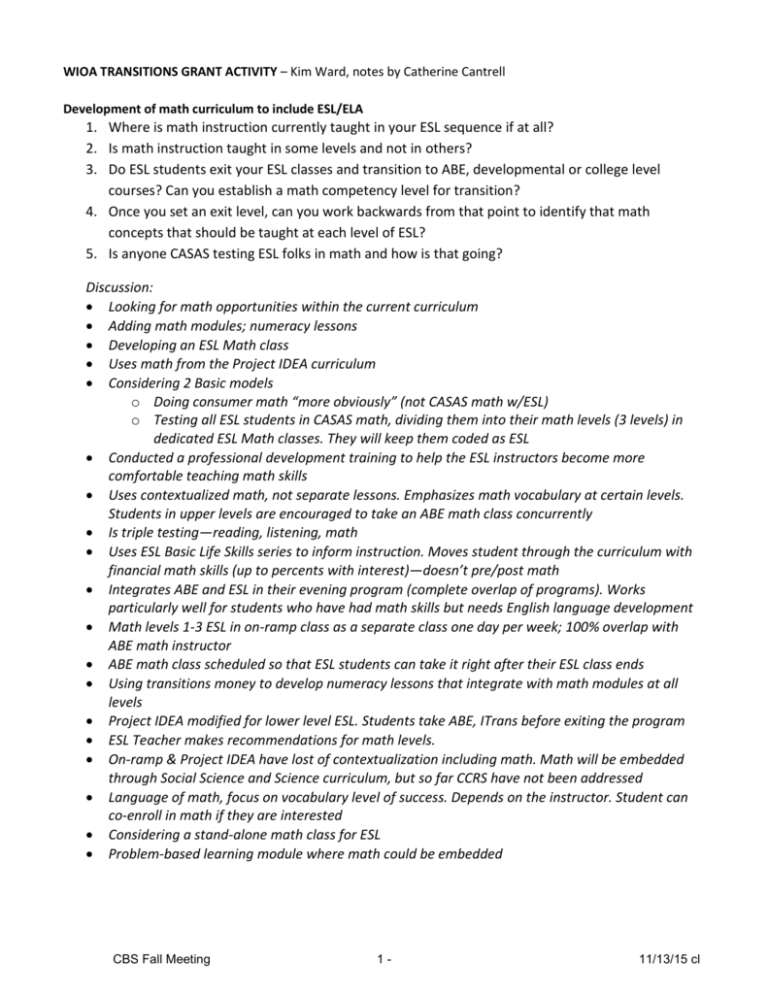
WIOA TRANSITIONS GRANT ACTIVITY – Kim Ward, notes by Catherine Cantrell Development of math curriculum to include ESL/ELA 1. Where is math instruction currently taught in your ESL sequence if at all? 2. Is math instruction taught in some levels and not in others? 3. Do ESL students exit your ESL classes and transition to ABE, developmental or college level courses? Can you establish a math competency level for transition? 4. Once you set an exit level, can you work backwards from that point to identify that math concepts that should be taught at each level of ESL? 5. Is anyone CASAS testing ESL folks in math and how is that going? Discussion: Looking for math opportunities within the current curriculum Adding math modules; numeracy lessons Developing an ESL Math class Uses math from the Project IDEA curriculum Considering 2 Basic models o Doing consumer math “more obviously” (not CASAS math w/ESL) o Testing all ESL students in CASAS math, dividing them into their math levels (3 levels) in dedicated ESL Math classes. They will keep them coded as ESL Conducted a professional development training to help the ESL instructors become more comfortable teaching math skills Uses contextualized math, not separate lessons. Emphasizes math vocabulary at certain levels. Students in upper levels are encouraged to take an ABE math class concurrently Is triple testing—reading, listening, math Uses ESL Basic Life Skills series to inform instruction. Moves student through the curriculum with financial math skills (up to percents with interest)—doesn’t pre/post math Integrates ABE and ESL in their evening program (complete overlap of programs). Works particularly well for students who have had math skills but needs English language development Math levels 1-3 ESL in on-ramp class as a separate class one day per week; 100% overlap with ABE math instructor ABE math class scheduled so that ESL students can take it right after their ESL class ends Using transitions money to develop numeracy lessons that integrate with math modules at all levels Project IDEA modified for lower level ESL. Students take ABE, ITrans before exiting the program ESL Teacher makes recommendations for math levels. On-ramp & Project IDEA have lost of contextualization including math. Math will be embedded through Social Science and Science curriculum, but so far CCRS have not been addressed Language of math, focus on vocabulary level of success. Depends on the instructor. Student can co-enroll in math if they are interested Considering a stand-alone math class for ESL Problem-based learning module where math could be embedded CBS Fall Meeting 1- 11/13/15 cl Development of effective and accessible college and career pathways 1. Do ESL students exit your ESL classes and transition to ABE, Developmental or college level courses? Can you establish a math competency level for transition? 2. What are the transition points for both ABE and ESL? 3. How are you dealing with the ABE and Developmental overlap, who are you working with on your campus and how did you approach them to get buy in? What are some strategies you have tried to address the overlap? 4. What curricular, student support, assessment, and articulation issues you have struggled with? 5. How do you plan to respond to the new EL Civics funding requirements (integrated pathways etc.)? 6. How are you documenting your pathways? 7. How are you bringing basic skills into the statewide conversation around structured pathways and meta-majors? 8. How are CBO’s and colleges working together to implement and/or develop pathways? Discussion: Capitalize on the math department’s on-line instruction tool (ALEKS—math department spends $30,000/yr on it) to award ABE students credit towards a high school diploma. Forestalling the fight…what if ABE takes all pre-college student without a secondary credential and dev ed take those with one Is using EL Civics money towards developing IBEST pathways Individuals who want to go to college register into a multilevel class with a chance to work on deficiencies and test out higher. Use AZTEC Software and Office software to work budgets and other things related to work. Building relationships with English and math departments. Have articulation agreements in place so that students can transition without retesting. Math division has helped write the job description for the new ABE position Cluster developmental ed. English and ABE English together. Adjusting prerequisites for the next course (articulation agreement) (Someone had a question about how the articulation agreements play nicely with the reciprocity agreement) Align instruction to College and Career Readiness Standards (CCRS): 1. How far are you in the implementation of CCSR and how are you meeting deadlines for submitting and passing new coursework with curriculum committees? 2. How do you plan to address the potential misalignment between CCRS and your agency’s or college’s defined curriculum and pathways? 3. How are you preparing your instructors and volunteers to implement the CCRS? What local PD activities have you done or are you planning? Have you developed any local curriculum, assessment tools, or rubrics? Discussion: ESL standards will be ready in two years, but their ready to start implementing now. Challenge: the standards are wordy. Teachers felt stuck because they don’t get it. They are rewriting them in language they can digest. CBS Fall Meeting 2- 11/13/15 cl Development of employability skills curriculum: 1. How are you defining employability skills and what does that look like in your curriculum? 2. How does employability differ between ESL and ABE in your program? 3. Do you scaffold employability skills throughout your curriculum or do you have designated points in which you teach a particular employability skill? 4. Where or how does the integration of employability skills fit into a HS21+ curriculum? Discussion Everyone is invited to respond to these questions via the CBS Canvas site Development of curriculum/programming that allows ESL/ELA students to attain a secondary school diploma or its recognized equivalent and transition to postsecondary education or training employment 1. How do you plan to develop your ESL pathway to ensure it leads to the attainment of HS diploma or equivalent? 2. How to you plan to develop your ESL pathway to ensure it leads to education and training and/or employment? 3. How do you plan to respond to the EL Civics funding requirements? 4. How are you restructuring your ABE and ESL programs? For example, are you collapsing ESL and ABE at some point? Are you implementing any type of team teaching? 5. What are some strategies you have employed to gain faculty and staff buy in? Discussion Everyone is invited to respond to these questions via the CBS Canvas site CBS Fall Meeting 3- 11/13/15 cl
